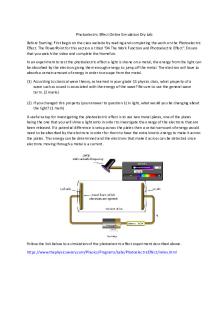04 The Work Function and Photoelectric Effect PDF

| Title | 04 The Work Function and Photoelectric Effect |
|---|---|
| Author | M. T. |
| Course | Physics |
| Institution | High School - Canada |
| Pages | 3 |
| File Size | 155.7 KB |
| File Type | |
| Total Downloads | 74 |
| Total Views | 141 |
Summary
Notes...
Description
04 The Work Function and Photoelectric Effect The Work Function - Metals contain electrons that are free to move within the metal, but they are still bound to the metal itself. - Energy is required to remove the electrons from the metal atoms
-
The minimum amount of energy required to remove a single electron from a piece of metal is call the work function
-
The work function has units of energy The amount of energy required to remove just one electron is relatively small, so for convenience scientists use a unit called an electron-volt (eV) One electron-volt is the amount of energy given to an electron that accelerates through a potential difference of one volt 1 eV = 1.60 × 10−19 J
-
The Photoelectric Effect - See youtube video: https://www.youtube.com/watch?v=RR4T1IlM2Jw -
If an electron, in a metal, absorbs an amount of light energy above that metal’s work function the electron will be ejected from the metal
-
See youtube video: https://www.youtube.com/watch?v=kcSYV8bJox8
-
No electrons will be emitted from a metal unless the frequency of the light hitting the metal is above the threshold frequency ( f0 )
-
Once the frequency is above f0, the kinetic energy of the emitted electrons varies linearly with the frequency ( f ) - The threshold frequency is independent of the intensity of light - The kinetic energy of the ejected electrons is independent of the light intensity - This is contrary to the classical wave model of light. If the intensity (amplitude) of light increases so should its energy The Solution: Einstein’s Quantum Theory of Light - Light can be thought of as a stream of particles called
-
photons When a photon collides with an electron on the surface of a metal the electron absorbs the photon and its energy An electron is most likely to absorb only one photon at a time If the energy of the photon is less than the work function, the electron will not have enough energy to escape and will simply re-emit the photon If the energy of the photon is greater than the work function, the electron will have enough energy to escape and will do so The amount of energy contained in a photon depends on its frequency (it is a linear relationship) Ephoton = hf
-
where h is Planck’s constant: h = 6.63 × 10−34 Js
The amount of kinetic energy contained in the ejected electron energy would be the energy of the photon ( hf ) minus the energy required to remove the electron (the work function, hf0 ) Ek = hf − W Ek = hf − hf0...
Similar Free PDFs

Photoelectric effect notes
- 6 Pages

C3 Photoelectric effect
- 3 Pages

Scavenger Hunt 04-The PC at Work
- 7 Pages

The Dependence Effect
- 3 Pages

The Police Role and Function 5.1
- 2 Pages

The Lifetime Utility Function
- 1 Pages

Circuit The polynomial Function
- 2 Pages
Popular Institutions
- Tinajero National High School - Annex
- Politeknik Caltex Riau
- Yokohama City University
- SGT University
- University of Al-Qadisiyah
- Divine Word College of Vigan
- Techniek College Rotterdam
- Universidade de Santiago
- Universiti Teknologi MARA Cawangan Johor Kampus Pasir Gudang
- Poltekkes Kemenkes Yogyakarta
- Baguio City National High School
- Colegio san marcos
- preparatoria uno
- Centro de Bachillerato Tecnológico Industrial y de Servicios No. 107
- Dalian Maritime University
- Quang Trung Secondary School
- Colegio Tecnológico en Informática
- Corporación Regional de Educación Superior
- Grupo CEDVA
- Dar Al Uloom University
- Centro de Estudios Preuniversitarios de la Universidad Nacional de Ingeniería
- 上智大学
- Aakash International School, Nuna Majara
- San Felipe Neri Catholic School
- Kang Chiao International School - New Taipei City
- Misamis Occidental National High School
- Institución Educativa Escuela Normal Juan Ladrilleros
- Kolehiyo ng Pantukan
- Batanes State College
- Instituto Continental
- Sekolah Menengah Kejuruan Kesehatan Kaltara (Tarakan)
- Colegio de La Inmaculada Concepcion - Cebu








